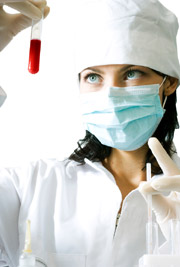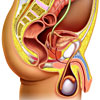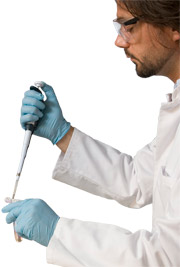- What is a testosterone test?
- When is a testosterone test used?
- Types of testosterone tests
 Performing a testosterone test
Performing a testosterone test - Interpreting the result of a testosterone test
- Accuracy of testosterone tests
- Associated healthcare
What is a testosterone test?
A testosterone test is a test which measures the amount of testosterone in a person's blood or saliva.
When is a testosterone test used?
A testosterone test is used when it is necessary to assess a person's testosterone levels. This is usually when a doctor suspects that the individual has a health condition which affects their testosterone and needs to confirm whether or not the person's testosterone level is normal, in order to make a diagnosis. The conditions for which a testosterone test may be used as a diagnostic tool differ between men and women.Men
In men, testosterone tests are used to:
- Confirm a suspected diagnosis of primary or secondary hypogonadism, a condition characterised by abnormally low testosterone levels;
- Monitor the effect of testosterone replacement therapy in men with testosterone deficiency;
- Evaluate the causes underlying delayed puberty in boys.
 | More information on hypogonadism. |
Women
In women, testosterone tests may be used to:
- Evaluate the causes underlying hyperandrogenism (a condition characterised by abnormally high testosterone levels), which may include:
- Idiopathic hirsutism (unexplained, excessive, male pattern hair growth, for example growth of excessive facial hair);
- Congenital adrenal hyperplasia (a birth defect in which the adrenal gland grows excessively);
- Polycystic ovarian syndrome (a condition of hormonal imbalance in which cysts grow on the ovaries and testosterone levels are abnormally elevated);
- Testosterone-producing tumours in the adrenal gland (a gland which produces hormones) or ovaries.
- Assess testosterone levels in women with suspected testosterone deficiency.
Types of testosterone tests
 Most of the testosterone in the body binds to carrier proteins (proteins which transport other substances such as hormones through the blood). These carrier proteins are called sex hormone binding globulin (SHBG) and albumin.
Most of the testosterone in the body binds to carrier proteins (proteins which transport other substances such as hormones through the blood). These carrier proteins are called sex hormone binding globulin (SHBG) and albumin. Some 44% of testosterone in the blood binds tightly to SHBG and this proportion of testosterone cannot bind to cells in the body which use testosterone (e.g. cells in the testes) because it is bound tightly to and cannot separate from SHBG. This proportion of testosterone is also known as unavailable testosterone, as it is unavailable to the body's cells.
A further 54% of testosterone in the blood binds loosely to albumin, but remains available to the body's cells, because it can separate from the albumin and bind to cells which use testosterone. This portion of testosterone is also called bio-available testosterone.
The remaining 2% of testosterone in the blood remains unbound and is also available to testosterone-using cells in the body. It is referred to as free testosterone.
Testosterone levels can be measured in terms of total, bio-available or free testosterone and there are various tests which can be used to measure levels of each type of testosterone.
 | More information on Testosterone. |
Total testosterone
Total testosterone measures free, albumin bound and SHBG bound testosterone in the blood and is the most commonly used measure of testosterone levels. It is the test usually used to assess testosterone levels in men with suspected hypogonadism or testosterone deficiency. There are several methods available to measure total testosterone.
Liquid or gas chromatography-tandem mass spectrometry
Liquid or gas chromatography, tandem mass spectrometry is the most accurate test or gold standard for measuring total testosterone. Unlike most testosterone tests, it is accurate enough to measure testosterone concentrations in women who have relatively low levels compared to men. However, the test is very complex to perform and although some laboratories in Australia do the test, it is not often used by doctors wishing to assess testosterone levels as it is too costly and time consuming.
Radioimmunoassay test kit
Radioimmunoassay test kits provide a relatively simple means of assessing testosterone levels. However, they are less accurate than liquid or gas chromatography-tandem mass spectrometry and unsuitable for assessing testosterone levels in women.
The test kits contain reagents which are added to an individual's blood sample. Testosterone antibodies with radioactive particles in the reagent bind to testosterone in the sample and the testosterone level is determined by counting the number of testosterone molecules bound to testosterone antibodies. They can be easily counted because of the radioactive particles to which they are attached.
Automated immunoassay systems Automated platform immunoassay systems are testosterone tests in which most steps (e.g. adding the blood sample, adding reagents) are performed automatically by a machine, rather by people in the laboratory. These tests are the fastest method of assessing testosterone levels. They are considered accurate enough for assessing testosterone levels in men but not in women.
Bio-available testosterone
 Bio-available testosterone is a measure of both free and albumin-bound testosterone, both of which are bio-available, or available for use by cells in the body.
Bio-available testosterone is a measure of both free and albumin-bound testosterone, both of which are bio-available, or available for use by cells in the body.Ammonium sulphate precipitation
The ammonium sulphate precipitation method is a test which measures bio-available testosterone. To perform this test, a chemical called aluminium sulphate is added to a blood sample. This causes SHBG-bound testosterone to precipitate (separate out and form a solid substance) from the sample. Bio-available testosterone (free and albumin-bound) remains in the sample. The total testosterone level of the sample (after precipitation of the SHBG-bound testosterone) is then measured. Aluminium sulphate precipitation is considered the gold standard (most accurate) measure of bio-available testosterone. It is however impractical for routine use by doctors, as it is too time-consuming and costly to perform.
Calculated bio-available testosterone
It is also possible to calculate bio-available testosterone using an equation, if total testosterone, SHBG and albumin levels are known.
Free testosterone
A test for free testosterone measures only the 2% of testosterone which remains unbound to proteins in blood. Tests are also available to measure free testosterone in saliva, however these are relatively new, require further testing and are currently only recommended for use in research studies and not for use by doctors for diagnosing patients.
Free testosterone levels may be measured in men whose total testosterone test results showed testosterone levels which are on the borderline of levels considered to indicate testosterone deficiency. Free testosterone levels are often assessed in women with suspected testosterone abnormalities. Free testosterone can be measured by a number of methods.
Equilibrium dialysis
Equilibrium dialysis is a complex measure of free testosterone in which a blood sample is diluted and passed through a special semi-permeable membrane into a buffer solution. Only some of the testosterone in the sample can pass through the membrane- the rest remains in the blood sample. After filtering the sample through the semi-permeable membrane, the amount of testosterone in the buffer solution and the sample is measured and used to calculate the concentration of free testosterone This test is considered the gold standard for measuring free testosterone but is impractical for routine use.
Centrifugal ultrafiltration
Centrifugal ultrafiltration is also an accurate measure of free testosterone, however considered impractical for routine use. The method involves adding a substance called testosterone tracer (usually a coloured substance which binds to testosterone and can then be easily identified because of its colour) to blood samples, which are then incubated at 37oC and centrifuged (spun at a high speed) to separate the testosterone in the sample. The concentration of free testosterone can then be measured by examination of the filtrate (the separated portion of the sample).
Direct immunoassay test kits
Direct immunoassay test kits are the easiest and fastest available methods of assessing free testosterone. They are test kits in which reagents containing testosterone antibodies and tracer particles (either radioactive or non-radioactive) which bind to free testosterone in the sample. The tracer particles are easily identifiable and can be counted to measure the concentration of free testosterone in the sample. The results are less accurate than other methods though and lower results are typically obtained compared to equilibrium dialysis.
Calculated free testosterone
There are also a number of equations for calculating the concentration of free testosterone in a blood sample, without making an actual measurement of free testosterone. Other substances in the blood which interact with testosterone are measured instead. For example, measuring total testosterone and sex hormone binding globulin allows a measure of total testosterone called the Free Androgen Index to be calculated.
Performing a testosterone test
MenTestosterone tests for men are performed using a morning blood sample, as testosterone levels in men fluctuate throughout the day and are highest in the morning. All abnormal results should be confirmed with repeat testing as testosterone levels also fluctuate considerably from day to day, within individual men. As some illnesses affect testosterone production, the tests should not be performed when a man is ill.
Women
Women also experience testosterone level fluctuations throughout the day and a morning blood sample should be used to assess women's testosterone levels. In addition, women's testosterone levels fluctuate throughout the menstrual cycle and thus testosterone tests performed at different stages of the menstrual cycle could be expected to give different results. However, as testosterone tests are only useful for identifying abnormally high testosterone levels in women, fluctuations due to different stages of the menstrual cycle are unlikely to be great enough to affect the clinical meaning of test results. When women's testosterone levels are tested for research purposes (e.g. to compare the accuracy of different types of testosterone tests) multiple measures may be taken for each woman, at different stages of the menstrual cycle.
Interpreting the result of a testosterone test
MenThe interpretation of test results varies depending on the condition being diagnosed and the age of the man being tested. An experienced health professional will need to interpret the test results.
Total testosterone is usually used to determine whether or not testosterone levels are normal, too high or too low. Levels of bio-available or free testosterone are not used to assess whether or not testosterone levels are sufficient or deficient, but may be used to help a doctor determine the underlying cause of an abnormal total testosterone level, as the relative proportions of total, bound and unbound testosterone are different for different conditions.
Women
Interpreting the results of testosterone tests performed for women is difficult, as there is no agreed upon testosterone concentration which indicates testosterone deficiency or excessive testosterone. The results of blood testosterone tests are usually considered in conjunction with clinical symptoms which may indicate testosterone abnormalities (e.g. reduced libido indicates deficiency while excessive hair growth indicates elevated testosterone levels).
For women, the results of a total testosterone test are usually also interpreted in conjunction with the results of tests for free or bio-available testosterone, as female conditions associated with hyperandrogenism (excessive testosterone levels) as well as ageing and pregnancy affect SHBG concentrations and therefore influence the relative proportions of testosterone in the blood which are free, albumin-bound and SHBG-bound.
Accuracy of testosterone tests
MenYoung men (< 40)
 Simple tests for total testosterone (immunoassay, automated platform immunoassays) are generally considered accurate enough for detecting testosterone deficiency in men, as their results are similar to those obtained using liquid or gas chromatography, tandem mass spectrometry (the gold standard or most accurate measure of total testosterone). However, these simple tests consistently return lower results than the gold standard measure, which may make diagnosing men with mild hypogonadism (testosterone levels in the upper range of hypogonadal levels) challenging.
Simple tests for total testosterone (immunoassay, automated platform immunoassays) are generally considered accurate enough for detecting testosterone deficiency in men, as their results are similar to those obtained using liquid or gas chromatography, tandem mass spectrometry (the gold standard or most accurate measure of total testosterone). However, these simple tests consistently return lower results than the gold standard measure, which may make diagnosing men with mild hypogonadism (testosterone levels in the upper range of hypogonadal levels) challenging.Ageing men (≥ 40)
Total and free testosterone measures are no more accurate than total testosterone for predicting testosterone deficiency in men. As total testosterone is a more simple test to perform it is the test usually used by doctors to diagnose testosterone deficiency.
Women
Most testosterone tests are insensitive for assessing low levels of testosterone, such as may be found in pre-menopausal women with testosterone deficiency. The only sufficiently sensitive test (liquid chromatography-tandem mass spectrometry) is impractical for use in routine clinical practice. Simple tests for measuring testosterone levels in women at various life stages are needed.
Associated healthcare
MenFor a diagnosis of hypogonadism, luteinising hormone and follicle stimulating hormone (two hormones produced by the pituitary gland) levels are often also tested to distinguish primary and secondary causes of testosterone deficiency. Low levels of the hormones produced by the pituitary gland indicate secondary hypogonadism, as this condition is caused by a dysfunction in the pituitary gland which inhibits its ability to produce luteinising hormone and follicle stimulating hormone. Men who are diagnosed with hypogonadism are often offered testosterone replacement therapy.
 | More information on Testosterone replacement therapy in men. |
Women
A test for total testosterone levels in women is generally combined with a measurement of SHBG levels, as these measures allow the calculation of the proportions of bio-available testosterone. Women who are found to be testosterone deficient may benefit from testosterone replacement therapy, although this therapy is currently not approved by the government for use in women. Women who have excessively high testosterone levels are likely to undergo further tests in order to identify the condition causing excessive androgen levels.
More information
 | For more information on testerone deficiency in men, see Testosterone Deficiency. |
Reference
- Matsumoto AM, Bremner WJ. Serum testosterone assays: Accuracy matters. J Clin Endocrinol Metab. 2004;89(2):520-4.
- Wood P. Salivary steroid assays: Research or routine? Ann Clin Biochem. 2009;46(Pt 3):183-96.
- Allan CA, McLachlan RI. Testosterone deficiency in men: Diagnosis and management. Aust Fam Physician. 2003;32(6):422-7.
- Margo K, Winn R. Testosterone treatments: Why, when and how? Am Fam Physician. 2006;73(9):1591-8.
- Wang C, Catlin DH, Demers LM, et al. Measurement of total serum testosterone in adult men: Comparison of current laboratory methods versus liquid chromatography-tandem mass spectrometry. J Clin Endocrinol Metab. 2004;89(2):534-43.
- Bhasin S. Female androgen deficiency syndrome: An unproven hypothesis. J Clin Endocrinol Metab. 2005;90(8):4970-2.
- Miller KK, Rosner W, Lee H, et al. Measurement of free testosterone in normal women and women with androgen deficiency: Comparison of methods. J Clin Endocrinol Metab. 2004;89(2):525-33.
- University of California San Francisco Clinical Laboratory. Total testosterone: ADVIA Centaur System [online]. University of California San Francisco; September 2008 [cited 3 February 2010]. Available from URL: http://labmed.ucsf.edu/labmanual/db/resource/Centaur_Testosterone.pdf
- Vermeulen A, Verdonck L, Kaufman JM. A critical evaluation of simple methods for the estimation of free testosterone in serum. J Clin Endocrinol Metab. 1999;84(10):3666-72.
- Bhasin S, Bagatell CJ, Bremner WJ, et al. Issues in testosterone replacement in older men. J Clin Endocrinol Metab. 1998;83(10):3435-48.
- Christ-Crain M, Meier C, Huber P, et al. Comparison of different methods for the measurement of serum testosterone in the aging male. Swiss Med Wkly. 2004;134(13-14):193-7.
- Carruthers M, Trinick TR, Wheeler MJ. The validity of androgen assays. Aging Male. 2007;10(3):165-72.
- Ly LP, Handelsman DJ. Empirical estimation of free testosterone from testosterone and sex hormone binding globulin immunoassays. Eur J Endocrinol. 2005;152(3):471-8.
- Vermeulen A, Stoïca T, Verdonck L. The apparent free testosterone concentration: An index of androgenicity. J Clin Endocrinol Metab. 1971;33(5):759-67.
- Free testosterone ELISA [online]. San Diego, CA: Bio-Quant Diagnostics; 15 January 2008 [cited 3 February 2010]. Available from URL: http://www.bqkits.com/shopcart/images/product/BQ 014S - Free Testosterone.pdf
- Kapoor P, Luttrell BM, Williams D. The free androgen index is not valid for males. J Steroid Biochem Mol Biol. 1993;45(4):325-6.
- North American Menopause Society. The role of testosterone therapy in postmenopausal women: Position statement of the North American Menopause Society. Menopause. 2005;12(5):496-511.
- Winters SJ, Kelley DE, Goodpaster B. The analog free testosterone assay: Are the results in men clinically useful? Clin Chem. 1998;44(10):2178-82.
- Davis SR, Davison SL, Donath S, Bell RJ. Circulating androgen levels and self-reported sexual function in women. JAMA. 2005;294(1):91-6.
- Herold DA, Fitzgerald RL. Immunoassays for testosterone in women: Better than a guess? Clin Chem. 2003;49(8):1250-1.
- Swerdloff RS, Wang C. Free testosterone measurement by analog displacement direct assay: Old concerns and new evidence. Clin Chem. 2008;54(3):458-60.
- Wierman ME, Basson R, Davis SR, et al. Androgen therapy in women: An Endocrine Society Clinical Practice guideline. J Clin Endocrinol Metab. 2006;91(10):3697-710.